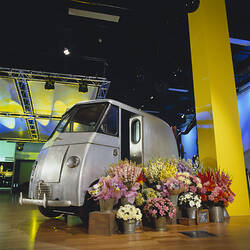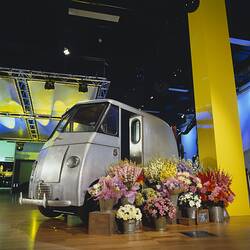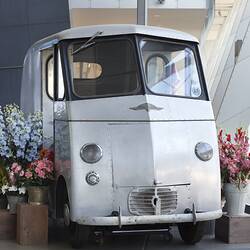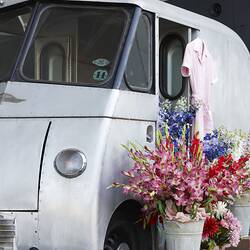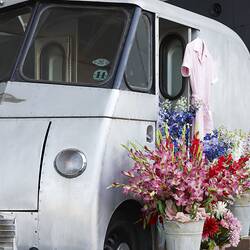Summary
Prototype for a small delivery vehicle, constructed in 1947 at the Commonwealth Aircraft Corporation (CAC) factory at Fishermans Bend, Victoria. It was powered by a modified 597cc BMW twin-cylinder motor cycle engine believed to be sourced from a BMW R66 motorcycle. With World War II ending in 1945, orders for military aircraft were greatly reduced. The delivery vehicle project could utilise the aircraft manufacturing technology and materials already in the factory. CAC also began producing pressure-cookers and bathtubs in the post-war years.
Dubbed the Deliverette, it was designed especially for city deliveries. The narrow aluminium body allowed it to be driven down tight laneways or onto the footpath. The tall open sides flush to the kerb and saddle seat let the driver leap in and out with ease.
The prototype generated strong interest. Milkmen, bakers, hot-food vendors, ice-cream sellers, laundry services and the Post Office all saw merit in the odd but practical vehicle. A florist was especially enthusiastic. She told the company it would enable her to deliver flowers already arranged in vases. Production plans were shelved when the Korean War broke out in 1950 and aircraft orders began to increase. The Deliverette project proved to be a useful experience for CAC which later made bodies for the long-lasting and popular range of Comair buses based on Bedford chassis units.
The prototype was acquired and owned for many years by Sir Laurence Hartnett, former Managing Director of General Motors Holden. After he passed away it was briefly owned by a car dealer in Rosebud, then in 1987 it was purchased by the Museum.
More Information
-
Collecting Areas
-
Acquisition Information
Purchase
-
Manufacturer
Commonwealth Aircraft Corporation, Fishermans Bend (Fishermen's Bend), Greater Melbourne, Victoria, Australia, 1948
-
Company Manager/Director
Sir Lawrence Wackett, Fishermans Bend (Fishermen's Bend), Greater Melbourne, Victoria, Australia
-
User
-
Brand Names
-
Classification
-
Category
-
Discipline
-
Type of item
-
Overall Dimensions
3965 mm (Length), 1620 mm (Width), 2280 mm (Height)
-
References
[Journal] Cook, Damien. BeeEm - Magazine of the BMW Motorcycle Club of Victoria., Jan 2007, p.18 Pages
-
Keywords
Aircraft Manufacturing, Delivery Vans, Internal Combustion Engines, Motor Vans

